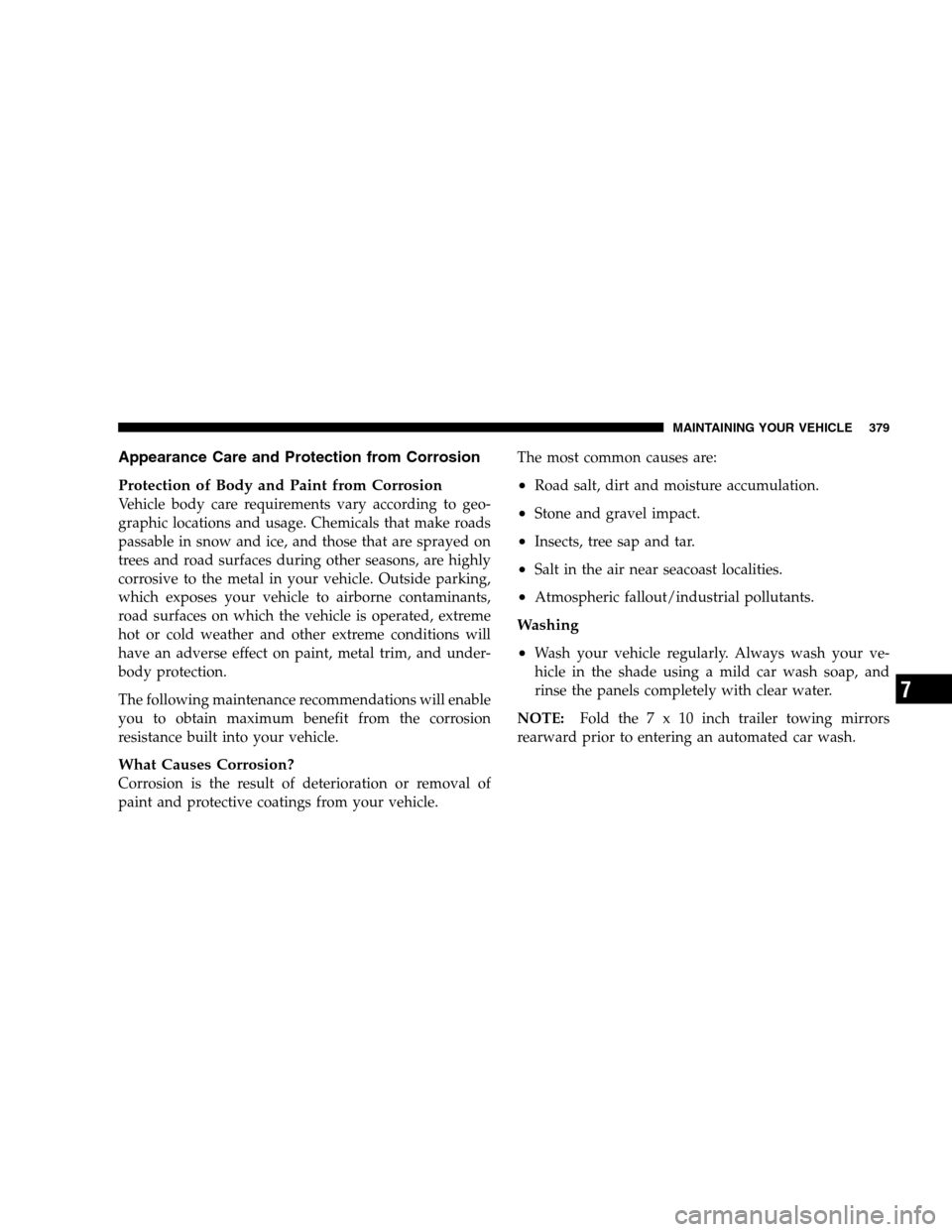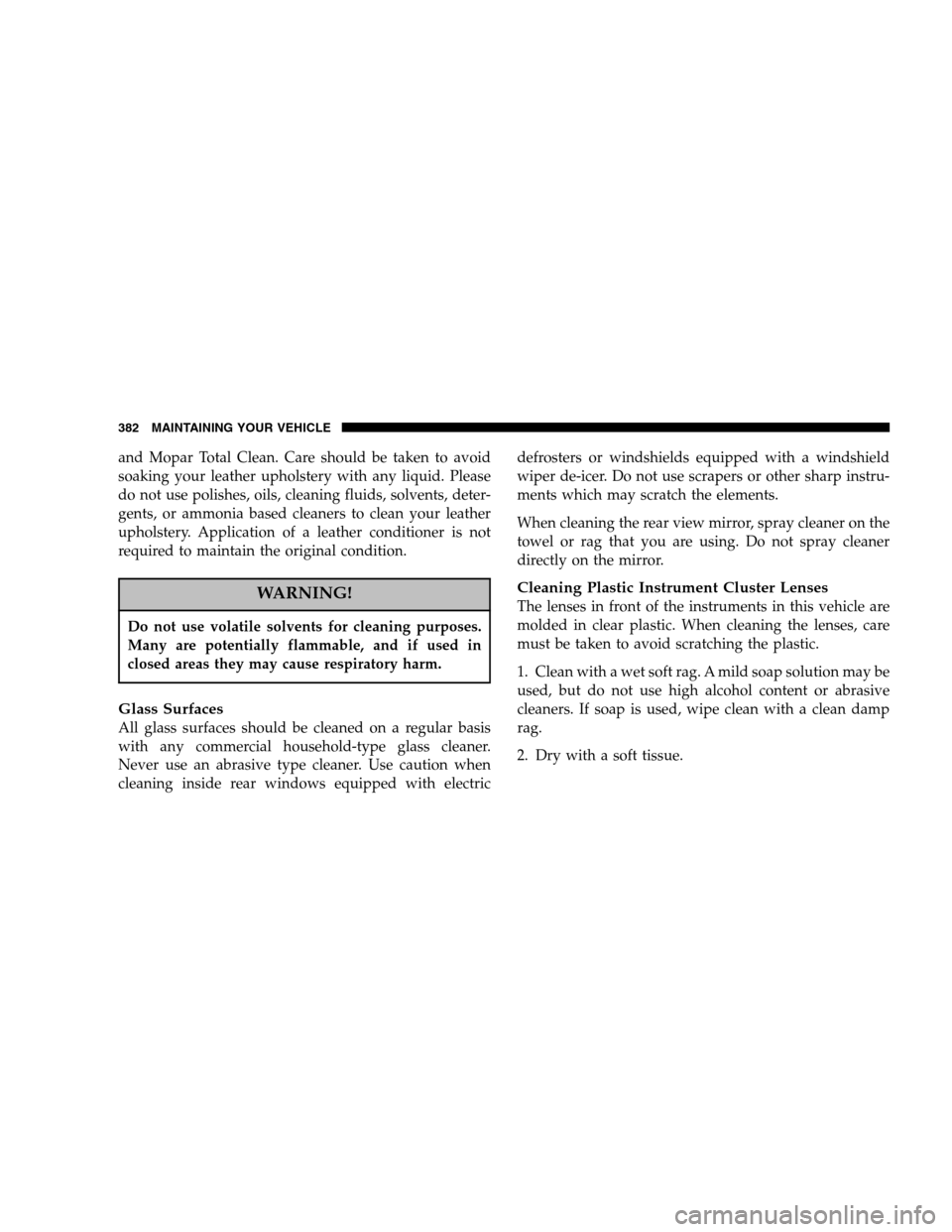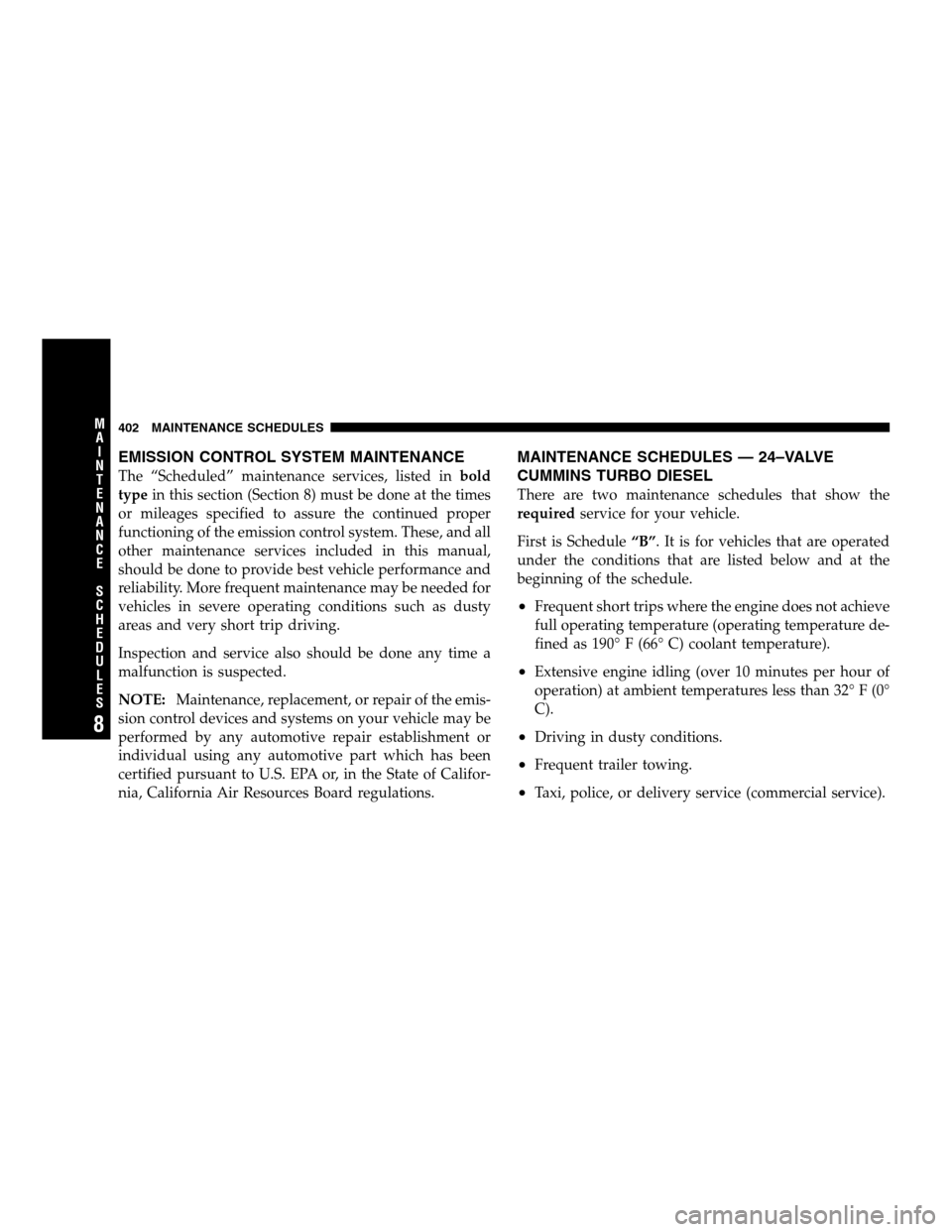Page 372 of 448

CAUTION!
Using a transmission fluid other than the manufac-
turers recommended fluid may cause deterioration
in transmission shift quality and/or torque converter
shudder. Using a transmission fluid other than the
manufacturers recommended fluid will result in
more frequent fluid and filter changes. Refer to
Recommended Fluids, Lubricants and Genuine Parts
for correct fluid type.
Automatic Transmission Fluid and Filter Change
To obtain best performance and long life for automatic
transmissions, the manufacturer recommends that they
be given regular maintenance service by an Authorized
Dodge Dealer or Service Center. It is important that the
transmission be adjusted periodically, the fluid main-
tained at the correct level, and that it be drained and
refilled as specified.It is important that proper lubricant is used in the
transmission. Refer to Recommended Fluids, Lubricants
and Genuine Parts for the correct lubricant type. A band
adjustment and filter change should be made at the time
of the oil change.
The fluid and filter(s) should be changed and the bands
adjusted (if equipped) ) as specified in the Maintenance
Schedule (Section 8). Vehicles having severe usage should
follow Maintenance Schedule “B” of the Maintenance
Schedule (Section 8).
Severe usage consists of:•Off-the-highway operation;
•Trailer towing;
•Snow plow operation;
•Prolonged operation with heavy loading, especially in
hot weather.
372 MAINTAINING YOUR VEHICLE
Page 379 of 448

Appearance Care and Protection from Corrosion
Protection of Body and Paint from Corrosion
Vehicle body care requirements vary according to geo-
graphic locations and usage. Chemicals that make roads
passable in snow and ice, and those that are sprayed on
trees and road surfaces during other seasons, are highly
corrosive to the metal in your vehicle. Outside parking,
which exposes your vehicle to airborne contaminants,
road surfaces on which the vehicle is operated, extreme
hot or cold weather and other extreme conditions will
have an adverse effect on paint, metal trim, and under-
body protection.
The following maintenance recommendations will enable
you to obtain maximum benefit from the corrosion
resistance built into your vehicle.
What Causes Corrosion?
Corrosion is the result of deterioration or removal of
paint and protective coatings from your vehicle.The most common causes are:
•Road salt, dirt and moisture accumulation.
•Stone and gravel impact.
•Insects, tree sap and tar.
•Salt in the air near seacoast localities.
•Atmospheric fallout/industrial pollutants.
Washing
•
Wash your vehicle regularly. Always wash your ve-
hicle in the shade using a mild car wash soap, and
rinse the panels completely with clear water.
NOTE:Fold the7x10inch trailer towing mirrors
rearward prior to entering an automated car wash.
MAINTAINING YOUR VEHICLE 379
7
Page 380 of 448

CAUTION!
Do not attempt to fold the7x10inch trailer towing
mirrors forward. The7x10inch trailer towing
mirrors are not designed to be folded forward and
doing so will damage the mirrors and/or vehicle.
•If insects, tar or other similar deposits have accumu-
lated on your vehicle, wash it as soon as possible.
•Use Mopar auto polish to remove road film and stains
and to polish your vehicle. Take care never to scratch
the paint.
•Avoid using abrasive compounds and power buffing
that may diminish the gloss or thin out the paint
finish.
CAUTION!
Do not use abrasive or strong cleaning materials
such as steel wool or scouring powder, which will
scratch metal and painted surfaces.
Special Care
•
If you drive on salted or dusty roads or if you drive
near the ocean, hose off the undercarriage at least once
a month.
•It is important that the drain holes in the lower edges
of the doors, rocker panels and tailgate be kept clear
and open.
•If you detect any stone chips or scratches in the paint,
touch them up immediately. The cost of such repairs is
considered the responsibility of the owner.
380 MAINTAINING YOUR VEHICLE
Page 382 of 448

and Mopar Total Clean. Care should be taken to avoid
soaking your leather upholstery with any liquid. Please
do not use polishes, oils, cleaning fluids, solvents, deter-
gents, or ammonia based cleaners to clean your leather
upholstery. Application of a leather conditioner is not
required to maintain the original condition.
WARNING!
Do not use volatile solvents for cleaning purposes.
Many are potentially flammable, and if used in
closed areas they may cause respiratory harm.
Glass Surfaces
All glass surfaces should be cleaned on a regular basis
with any commercial household-type glass cleaner.
Never use an abrasive type cleaner. Use caution when
cleaning inside rear windows equipped with electricdefrosters or windshields equipped with a windshield
wiper de-icer. Do not use scrapers or other sharp instru-
ments which may scratch the elements.
When cleaning the rear view mirror, spray cleaner on the
towel or rag that you are using. Do not spray cleaner
directly on the mirror.
Cleaning Plastic Instrument Cluster Lenses
The lenses in front of the instruments in this vehicle are
molded in clear plastic. When cleaning the lenses, care
must be taken to avoid scratching the plastic.
1. Clean with a wet soft rag. A mild soap solution may be
used, but do not use high alcohol content or abrasive
cleaners. If soap is used, wipe clean with a clean damp
rag.
2. Dry with a soft tissue.
382 MAINTAINING YOUR VEHICLE
Page 402 of 448

EMISSION CONTROL SYSTEM MAINTENANCE
The “Scheduled” maintenance services, listed inbold
typein this section (Section 8) must be done at the times
or mileages specified to assure the continued proper
functioning of the emission control system. These, and all
other maintenance services included in this manual,
should be done to provide best vehicle performance and
reliability. More frequent maintenance may be needed for
vehicles in severe operating conditions such as dusty
areas and very short trip driving.
Inspection and service also should be done any time a
malfunction is suspected.
NOTE:Maintenance, replacement, or repair of the emis-
sion control devices and systems on your vehicle may be
performed by any automotive repair establishment or
individual using any automotive part which has been
certified pursuant to U.S. EPA or, in the State of Califor-
nia, California Air Resources Board regulations.
MAINTENANCE SCHEDULES — 24–VALVE
CUMMINS TURBO DIESEL
There are two maintenance schedules that show the
requiredservice for your vehicle.
First is Schedule“B”. It is for vehicles that are operated
under the conditions that are listed below and at the
beginning of the schedule.
•Frequent short trips where the engine does not achieve
full operating temperature (operating temperature de-
fined as 190° F (66° C) coolant temperature).
•Extensive engine idling (over 10 minutes per hour of
operation) at ambient temperatures less than 32° F (0°
C).
•Driving in dusty conditions.
•Frequent trailer towing.
•Taxi, police, or delivery service (commercial service).
402 MAINTENANCE SCHEDULES
8
M
A
I
N
T
E
N
A
N
C
E
S
C
H
E
D
U
L
E
S
Page 405 of 448
Schedule “B”
Follow schedule “B” if you usually operate your vehicle
under one or more of the following conditions.
•Frequent short trips where the engine does not achieve
full operating temperature (operating temperature de-
fined as 190° F (66° C) coolant temperature).
•Extensive engine idling (over 10 minutes per hour of
operation) at ambient temperatures less than 32° F (0°
C).
•Driving in dusty conditions.
•Frequent trailer towing.
•Taxi, police, or delivery service (commercial service).
•Off-road or desert operation.
•Extensive operation at high engine speeds (greater
than 2900 rpm) and loads (greater than 70% throttle).
NOTE:IfANYof these apply to you then change your
coolant every 102,000 miles (163 000 km) or 60 months,
whichever comes first and follow schedule “B” of the
�Maintenance Schedules�section of this manual.
SCHEDULE “B” 405
8
M
A
I
N
T
E
N
A
N
C
E
S
C
H
E
D
U
L
E
S
Page 435 of 448

Used Coolant......................... 364
Door Ajar............................. 164
Door Locks............................. 16
Door Opener, Garage..................... 134
Draining Fuel/Water Separator Filter.......... 351
Drive Belts............................ 348
Dual Rear Wheels.....................280,324
Electric Rear Window Defrost..........81,210,214
Electrical Power Outlets................... 143
Electronic Speed Control................... 124
Emergency Brake........................ 255
Emergency, In Case of
Freeing Vehicle When Stuck............... 331
Hazard Warning Flasher................. 314
Jacking............................. 318
Jump Starting......................... 327
Tow Hooks.......................... 331
Towing............................. 332Emission Control System Maintenance......... 402
Engine............................... 338
Air Cleaner.......................... 349
Block Heater.......................224,231
Break-In Recommendations................ 67
Compartment......................... 338
Coolant (Antifreeze).................363,398
Cooling............................. 361
Data Plate........................... 311
Identification......................... 338
Idling.............................. 233
Jump Starting......................... 327
Oil ..............................343,398
Oil Synthetic......................... 233
Runaway............................ 281
Temperature Gauge..................... 165
Ethylene Glycol Antifreeze................. 363
Exhaust Gas Caution................69,155,360
Exhaust System....................69,360,375
INDEX 435
10
Page 436 of 448

Exterior Lighting........................ 116
Fan .................................. 365
Filters
Engine Oil.....................343,346,398
Flashers
Turn Signal.......................... 118
Flat Tire Stowage.....................317,326
Fluid, Brake........................... 399
Fluid Capacities......................... 397
Fluid Level Checks
Brake............................... 367
Manual Transmission................... 370
Power Steering........................ 356
Transfer Case......................... 370
Fog Lights.......................... 117,396
Fold Flat Load Floor..................... 148
Four Wheel Drive....................... 243
Four-Way Hazard Flasher.................. 314Freeing A Stuck Vehicle................... 331
Front Axle..........................358,369
Fuel..............................281,315
Diesel.........................281,315,398
Gauge.............................. 168
Requirements......................... 281
Specifications......................... 284
Tank Capacity........................ 397
Fuses................................ 383
Garage Door Opener..................... 134
Gauges............................... 169
Coolant Temperature.................... 165
Fuel................................ 168
Oil Pressure.......................... 164
Speedometer......................... 164
Tachometer.......................... 163
Voltmeter............................ 162
Gear Ranges........................... 237
436 INDEX